Self-Reseeding Potential of Forage Annual Clovers in the South
Annual clovers (arrowleaf, ball, balansa, berseem, crimson, Persian, rose, subterranean, etc.) are cool-season legumes widely adapted and used in the southern United States (Figure 1). They improve grassy forage growth distribution, increase forage yield, and improve quality while reducing nitrogen fertilizer need. Clovers also help extend the growing season, thus reducing the costs of winter supplementation. They are generally very digestible and contain high levels of crude protein, leading to increased animal performance and profitability. They can also fix nitrogen and reduce nitrogen inputs in clover/grass mixtures.
Growing clovers with pasture grasses greatly enhances cost effectiveness in forage/livestock production. However, in some instances, clovers are considered undependable because of their poor reseeding potential. Annual clovers complete their life cycle each year. They are usually planted in the fall and cease production by late spring. Clovers can be reestablished annually by either replanting or allowing plants to propagate depending on reseeding ability.

Depending on natural reseeding might not be practical because of the increased risk of establishment failure. Favorable environmental conditions are necessary to establish adequate stands through natural reseeding. It is also necessary to use late-spring grazing management practices that enhance clover seed production. Most clovers that have reseeding potential will also produce a large percentage of “hard” seeds. A hard seed is a seed that does not swell or germinate within the first 12 months of being seeded. A hard seed has a tough, impermeable coat that does not allow water or air to reach the embryo, which delays germination for long periods of time. Hard seed may survive passage through the digestive tracts of animals and can remain viable in the soil for long periods of time.
This delayed germination of annual legumes grown in harsh environments helps maintain stands when conditions are not favorable for seed production in a particular year. The quantity of hard seed depends on the conditions during flowering, seed formation, and maturation. For example, the amount of hard seed a plant produces during drought conditions can increase by 40 to 60 percent. For natural reseeding to occur, grazing and hay harvest should be managed to allow some of the clover to mature in late spring for seed production. Clover species that produce a high percentage of hard seed provide more dependable volunteer stands than those that produce more non-hard seed.
Self-reseeding annual clover crops can regenerate stands in subsequent years without tillage and can be part of a strategy to protect the existing sod or to protect soil from erosion. Tables 1 and 2 provide a summary of some of the characteristics and seeding rates for the most common annual clovers grown for forage in Mississippi.
|
Clover |
Common use |
Flowering date |
Relative maturity |
Reseeding ability |
|
arrowleaf |
grazing/hay |
early to mid-May |
late |
high |
|
balansa |
grazing/hay |
late April |
late |
high |
|
ball |
grazing |
early April |
medium |
high |
|
berseem |
grazing |
mid-April |
medium to late |
low |
|
crimson |
grazing |
mid-March to early April |
early |
low |
|
Persian |
grazing |
mid-April |
medium |
high |
|
rose |
grazing |
mid-April |
medium |
high |
|
subterranean |
grazing |
early April |
medium |
low |
|
|
Monoculture |
Mix |
||
|
Annual clover species |
Drill |
Broadcast |
Drill |
Broadcast |
|
|
pounds/acre |
|||
|
arrowleaf |
7 |
10 |
6 |
8 |
|
balansa |
5 |
8 |
3 |
5 |
|
ball |
2 |
3 |
3 |
4 |
|
berseem |
15 |
20 |
8 |
12 |
|
crimson |
15 |
20 |
8 |
10 |
|
Persian |
7 |
10 |
5 |
8 |
|
subterranean |
10 |
20 |
8 |
10 |
Figure 2 provides a state average production for some of the clovers tested at different locations in the MSU forage variety-testing program. Biomass production is correlated with rainfall for these cool-season, annual clover species in some cases due to their shallower rooting structure.
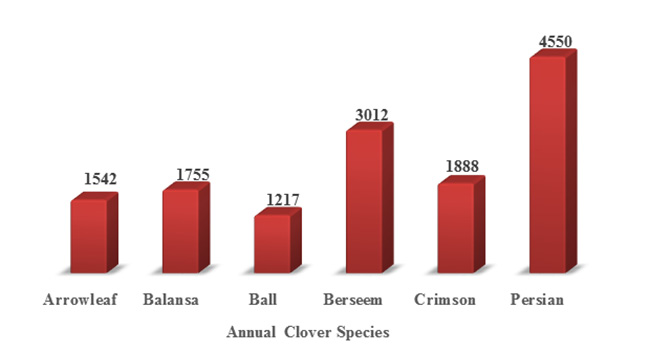
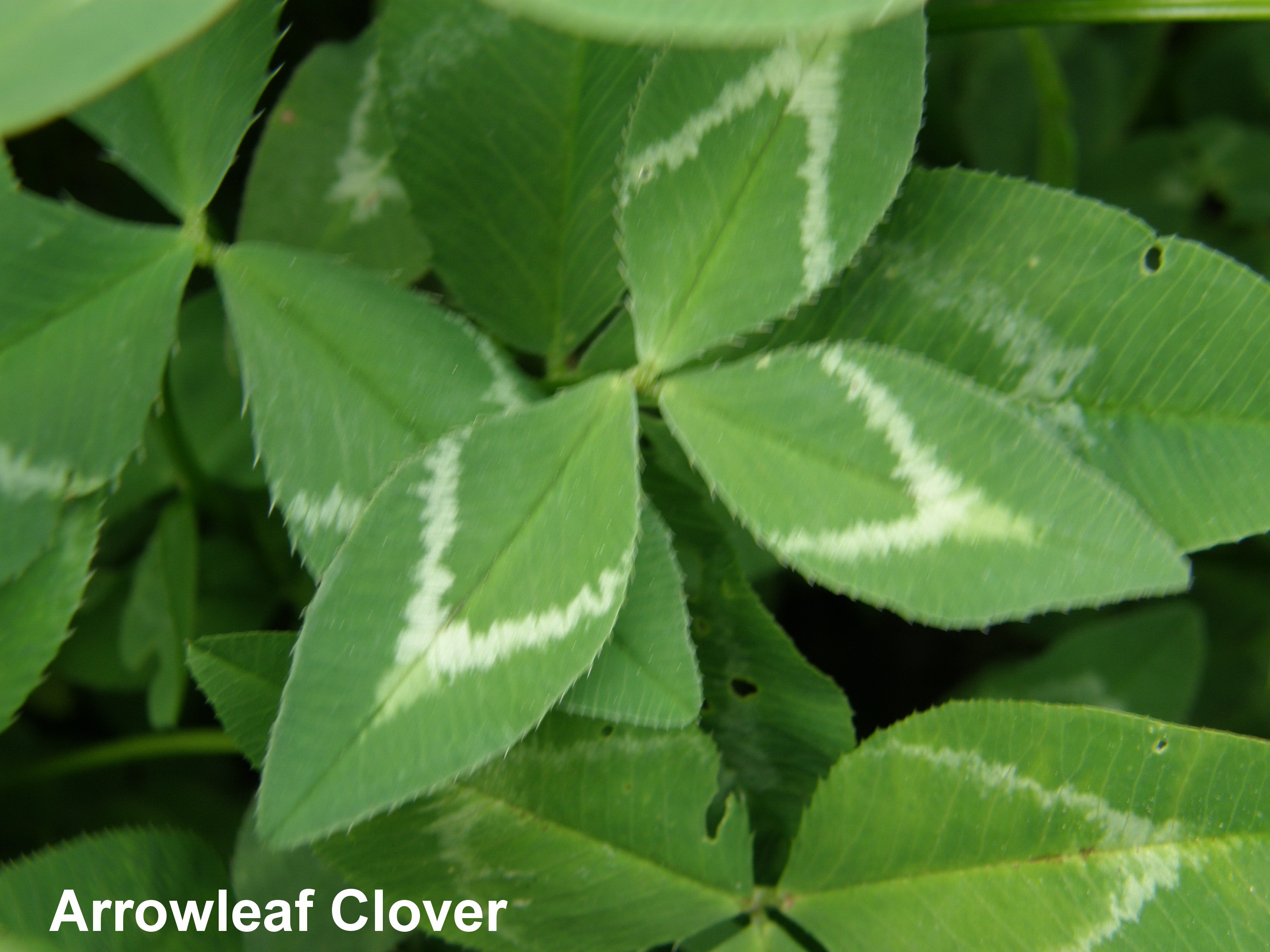
Arrowleaf clover (Trifolium vesiculosum) is a late-maturing, tall, upright clover that produces most of its growth in late spring and can maintain productivity through late May. Arrowleaf clover is a prolific seed producer, with a high proportion of hard seed. Hard seed production ranges from 75 to 90 percent. The flowers bloom from bottom to top, and the flower head will continue to grow taller and produce more seed as long as growing conditions are optimal. Arrowleaf does not tolerate wet soils, soil acidity, or shade. If allowed to grow too tall before grazing, the shading factor causes the lower leaves to die and become susceptible to disease. It is best to graze at 6 inches and then let it regrow. If arrowleaf clover has been grown in a pasture for several years, its ability to reestablish from seed dependably is seriously compromised by a Fusarium seedling disease complex.
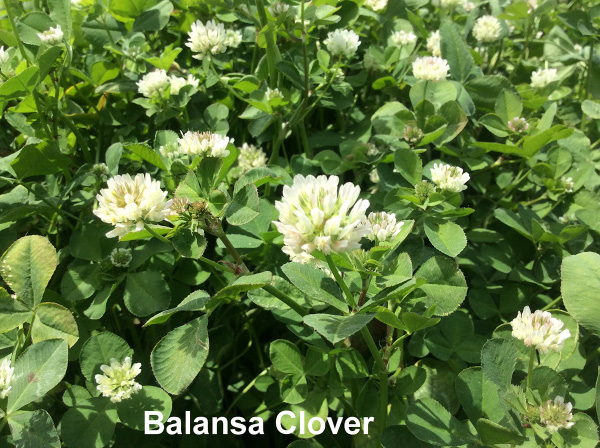
Balansa clover (Trifolium michelianum) is an upright clover with tolerance to heavy clay to sandy soil types. It can withstand a wide range of soil pH (4.5 to 8.5). Balansa is also tolerant to waterlogged soils and short flooding periods. One of the advantages is the rapid seed germination that allows a multi-branched rosette with hollow stems to develop from a single taproot. This allows for better grazing tolerance. At the reproductive stage, balansa clover is capable of producing large amounts of hard seed that can increase the reseeding potential for the next growing season. One of the disadvantages is that balansa has only 20 to 40 percent hard seed at establishment.
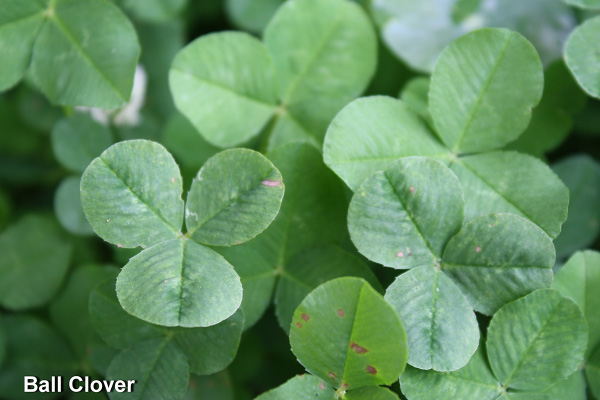
Ball clover (Trifolium nigrescens) is a low-growing clover that tolerates close grazing. It has poor drought tolerance. It is adapted to loam and clay-loam soil types and prefers bottomland with good moisture. It has a high cold tolerance but does not do well if soil pH drops below 6.0. Ball clover starts forage production later than most clovers. It is a late-maturing and late-producing clover, similar to arrowleaf clover, and often yields less than other commonly grown annual clovers. Ball clover is an excellent reseeder because it produces 60 to 80 percent hard seed and much of its seed is produced close to the ground. It will produce some flowers even under close grazing. Ball clover produces most of its growth in late April to early May and generally produces slightly less total forage biomass than other annual clovers.
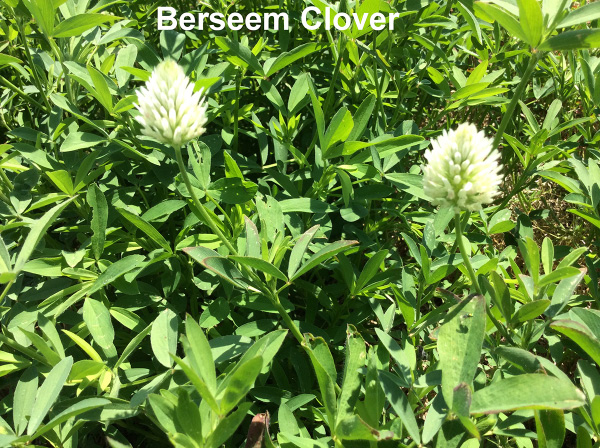
Berseem clover (Trifolium alexandrium), also known as Egyptian clover, is an erect-growing legume with hollow stems and a short taproot. It resembles alfalfa and has a small (4- to 6-inch) taproot. It is adapted to loam, clay loam, and clay soils and has good tolerance to poor drainage and alkaline soil conditions. Berseem is not very cold tolerant; it is very susceptible to temperatures below 30ºF. Berseem clover has been traditionally used in cover crop systems, but it has the potential to produce high biomass when inter-seeded with small grains or annual ryegrass for grazing. Berseem clover produces a large amount of seed but very little (about 10 percent) hard seed, so natural reseeding may be undependable. It is susceptible to frost kill in spring plantings. It has been reported that berseem clover does not produce bloating in grazing cows. Rotational stocking is the best way to use berseem clover pastures.
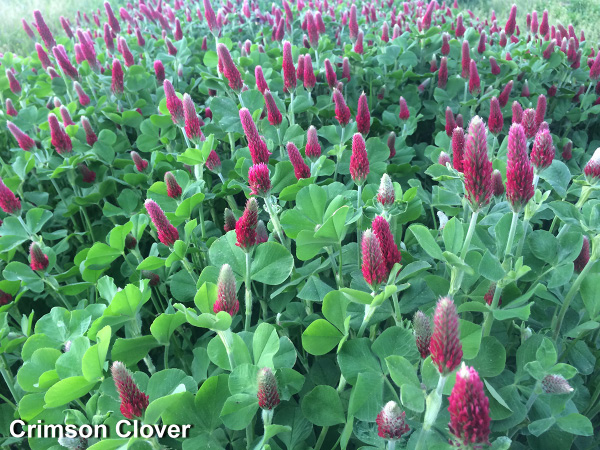
Crimson clover (Trifolium incarnatum) is the earliest maturing annual clover; it matures 1 month earlier than ball clover. Range in maturity of present varieties is about 12 days. Flowers open from the bottom of the flower head to the top. Flower development is influenced by temperature and photoperiod. If the weather is hot and sunny, all the blooms open at once; when this happens, not every flower is pollinated, so the seed yield is lower. It produces relatively little hard seed, and clover head weevils often damage its seed heads. As a result, crimson clover usually does not reseed well in a grazing system. Its hard-seed content averages about 35 percent after seed maturation, but, 90 days later, it can decrease to 10 percent. Most seed germinate with the first rain after seed maturation. Crimson clover is well suited to a variety of soils. It can persist in slightly acidic soil and can be productive in moderate to well-drained sandy and clayey soils. It is also well adapted to lower fertility situations. It does not tolerate waterlogging or saline soils. Crimson clover is preferred for overseeding warm-season pastures because it matures earlier than other annual clovers; therefore, it is less competitive with the warm-season grasses breaking dormancy and initiating growth in mid- to late spring. Crimson is moderately shade tolerant. For a better reseeding window, avoid grazing after mid-April to reduce flower density and seed production.
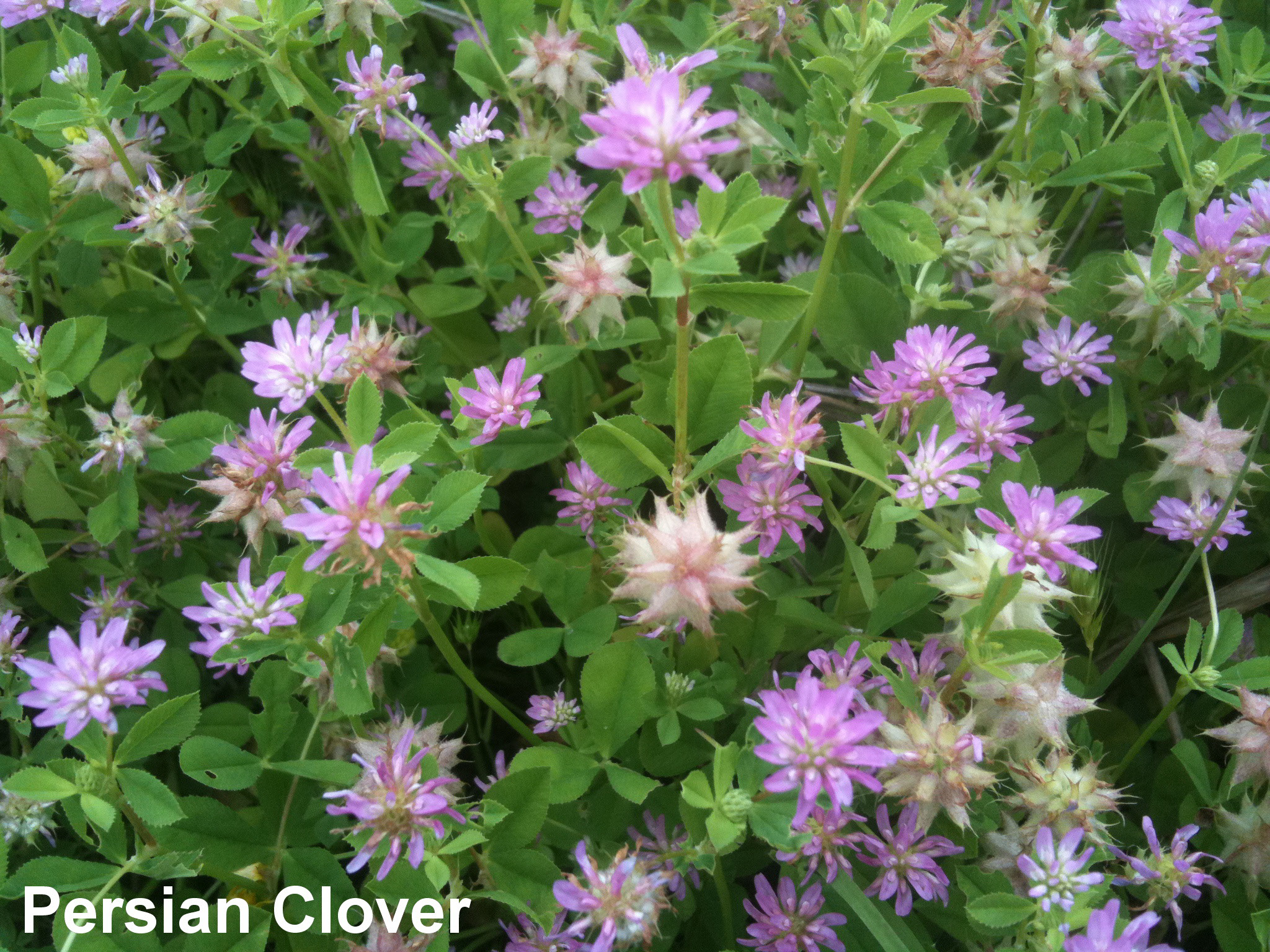
Persian clover (Trifolium resupinatum) is distinctive because of its toothed margins and pink flowers that produce olive-green to purple seeds. It is best adapted to heavy clay loam soils and poorly drained soils. Persian clover is not adapted to acid sandy soils. It has more drought tolerance than berseem clover and has fair cold tolerance. Persian clover can produce about 30 percent hard seed when allowed to mature. Despite being a cool-season, annual legume with a short growing season, Persian clover performs well under close grazing. Bloat is a serious concern for cattle consuming large quantities of biomass, but this has not been observed in sheep. Persian is considered one of the most dangerous clovers to cause bloat; never let animals graze a stand of over 40 to 50 percent Persian clover unless you are using a bloating block supplement. Annual ryegrass is a common companion plant with Persian clover, but it competes strongly for light and soil moisture. It recovers well from grazing, and, therefore, grass should be grazed often using short grazing cycles. However, limit grazing to avoid overgrazing, which will remove the stems. To maximize seed production during the year of establishment and ensure reseeding and long-term persistence, stands should not be grazed during the flowering period. On the other hand, on well-established stands of Persian clover, light grazing can occur during the flowering period but should be avoided if possible to optimize seed production and viability for the next growing season.
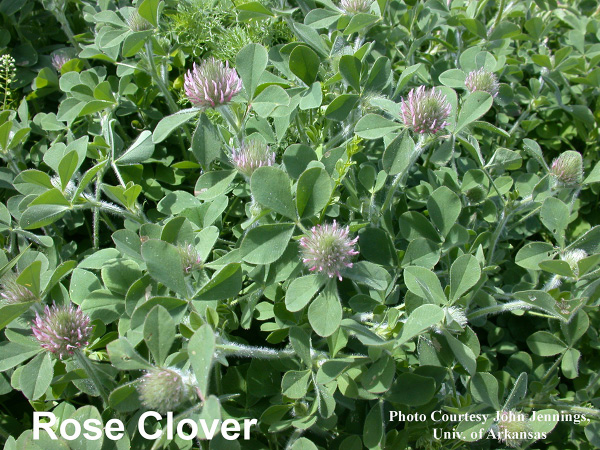
Rose clover (Trifolium hirtum) has two very distinctive characteristics: very hairy stems and pale green stipules. It is tolerant of poor fertility, drought conditions, and alkaline soils. Most of the drought tolerance is a result of rose clover’s deep rooting—deeper than crimson or arrowleaf clovers. Rose clover does not tolerate acid conditions or very wet soils. Rose clover is very tolerant to frost with a vigorous spring growth. It matures early in the season. Rose clover is an excellent reseeder because of a high hard-seed percentage (75 to 90). Rose clover can develop many tillers during the growing season and can flower under high grazing stocking rates, but animals should be removed in mid-April to allow the stand to produce seed. It has low bloating potential and is suited for moderate grazing. Rose clover will provide grazing from March to mid-May.

Subterranean clover (Trifolium subterraneum) is a low-growing clover (less than 1.5 feet tall), but it will create a very dense forage mat. This clover has a taproot and many fibrous branching roots. Due to its growth habit, subterranean can tolerate frequent close grazing and moderate shading by grasses better than other clovers. It is more adapted to areas with very mild winters. Subterranean clover is more tolerant to shade and low soil fertility conditions than most other annual clovers. Subterranean clover is adapted to medium to heavy textured soils such as clay and clay loam with good moisture-holding capacity. Subterranean clover usually flowers from March to May and matures from April to June. It has excellent reseeding potential because it buries its seed pods underground. Rainfall during seed maturation can cause low hard-seed percentage and result in unreliable reseeding. The wetter it is during pollination and seed set, the lower the percent of hard seed is produced. Reseeding appears to be better on heavy soils than lighter, sandy soils. Subterranean clover has very poor cold tolerance and might be best adapted to the southern part of Mississippi. Grazing management is an important component of managing subterranean clover because a thick mat of dead residue can keep seed dormant. Intensive grazing management works best in late spring and early summer to decrease residue.
Grazing Management for Reseeding
Grazing until early April often results in more seed production than not grazing at all. This is because heavy, dense growth results in lodged plants, matted forage, and reduced numbers of blooms. To allow adequate reseeding, remove livestock from the paddocks or reduce stocking rates in late April or early May (even into June) when the clover starts to bloom. During the 4- to 7-week flowering period, seeds mature in the bottoms of seed heads first, and some mature seed should be present by mid- to late May. Keep in mind that, when having clover mixtures in the same pasture, flower production might vary due to maturity of each species. It might be necessary to keep the animals off the pasture for a longer period of time. Differences in seed and flower production among species can range from 20 to 40 percent. Once the seed heads have matured, livestock could be returned to grazing those areas (Figure 3). Some clovers with low growth stature can tolerate close continued grazing and still have optimum seed production, resulting in a greater opportunity to reseed in pastures than clover species with more upright growth. Also, hard seed will pass through the animal and be deposited at other locations in the pasture.
Climate, especially temperature and rainfall, has a strong effect on annual clover establishment and reproduction. Successful establishment of annual legumes is achieved only with the use of varieties that have both high persistence and high productivity within the specific environment in which they are introduced. Self-reseeding annual legumes can play an increasingly important role in winter forage production because the cost of annual planting is eliminated. Annual legumes are flexible components within livestock enterprises to increase economic and environmental sustainability. For commercially available varieties in your area, check with your local forage seed provider.
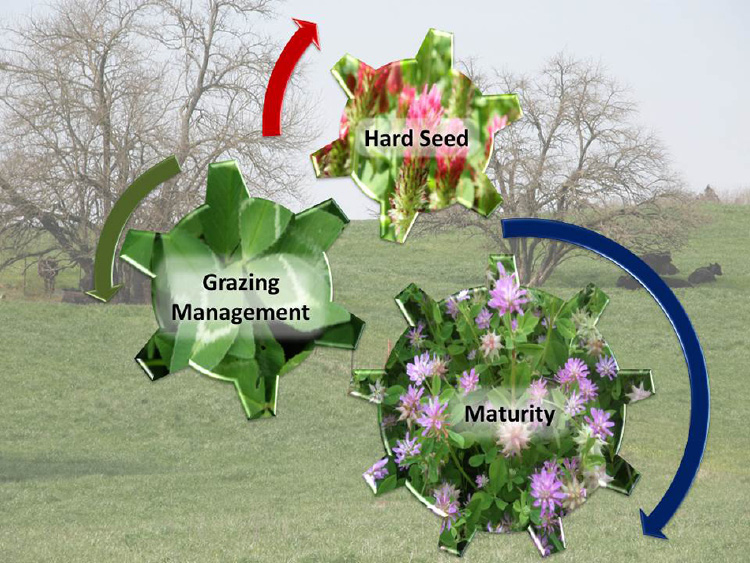
References
Ball, D.M., C.S. Hoveland, and G.D. Lacefield. 2015. Southern Forages. 5th Ed. International Plant Nutrition Institute. Norcross, GA.
Ball, D.M. and G.D. Lacefield. 2000. Clover Selection Guidelines. Circular 00-3, Oregon Clover Commission, Salem, OR.
Jennings, J. 2016. Value of Nitrogen Fixation from Clovers and Other Legumes. Univ. of Arkansas Coop. Ext. Serv. Pub. FSA2160.
Hoveland, C., R.G. Durham, and T. Terrill. 2000. Planting Winter Annual Clovers. Georgia Cattlemen, p. 30. Online at http://georgiaforages.caes.uga.edu/documents/GC0008.pdf (Verified August 31, 2017).
Kinght, W.E. 1985. Miscellaneous Annual Clovers. Clover Science and Technology, Agronomy Monograph No. 25, ASA-CSSA-SSSA, Madison, WI.
Phillip, D., J. Jennings, and P. Beck. 2013. Annual and Perennial Forage Clovers for Arkansas. Univ. of Arkansas Coop. Ext. Serv. Pub. FSA3137.
Smith, G.R., G.W. Evers, W.R. Ocumpaugh, F.M., Rouquette, Jr. 2010. Forage Legumes for Texas. Texas AgriLife Research. Online at http://aggieclover.tamu.edu/files/2010/06/ForageLegumesTexas.pdf (Verified August 31, 2017).
White, J., R. Lemus, J.R. Saunders, L. Fitzgerald, and B. Johnson. 2012. Mississippi Annual Cool-Season Forage Crop Variety Trials, 2011–12. Inf. Bull. 470.
White, J., R. Lemus, J.R. Saunders, L. Fitzgerald, and B. Johnson. 2013. Mississippi Annual Cool-Season Forage Crop Variety Trials, 2012–13. Inf. Bull. 479.
White, J., R. Lemus, J.R. Saunders, D. Rivera, and B. Johnson. 2014. Mississippi Annual Cool-Season Forage Crop Variety Trials, 2013–14. Info. Bull. 488.
White, J., R. Lemus, J.R. Saunders, D. Rivera, and B. Johnson. 2015. Mississippi Annual Cool-Season Forage Crop Variety Trials, 2014–15. Inf. Bull. 501.
White, J., R. Lemus, J.R. Saunders, D. Rivera, and B. Rushing. 2016. Mississippi Annual Cool-Season Forage Crop Variety Trials, 2015–16. Inf. Bull. 512.
White, J., R. Lemus, J.R. Saunders, D. Rivera, and B. Rushing. 2017. Mississippi Annual Cool-Season Forage Crop Variety Trials, 2016–17 (unpublished data).
Publication 3153 (POD-10-23)
By Rocky Lemus, PhD, Associate Extension/Research Professor.The Mississippi State University Extension Service is working to ensure all web content is accessible to all users. If you need assistance accessing any of our content, please email the webteam or call 662-325-2262.



